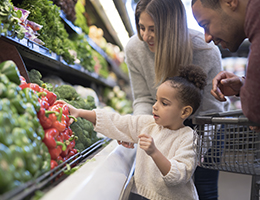
Remember this fact on your next grocery shopping trip: Fruits and vegetables are among the healthiest (and most delicious) foods you can put in your cart. Just check out some of their good-for-you benefits:
- They're filled with vitamins, minerals, fiber and other nutrients your body needs to function properly.
- They're good for your waistline. Fruits and veggies are nature's original low-calorie foods. And fiber-rich fruits and veggies may help you feel full longer.
- They're disease fighters. When you eat fruits and vegetables as part of an overall healthy diet, you could be helping to lower your risk for chronic diseases, including heart disease, high blood pressure, certain types of cancer and type 2 diabetes.
Budget-friendly buys
Those are just some of the reasons you need more fruits and veggies in your life. In fact, experts say you should fill half your plate with produce. But first you have to get them in your shopping cart and through the checkout line.
To fit more produce into your cart—and your budget—try these tips from the Academy of Nutrition and Dietetics and the U.S. Department of Agriculture:
1. Buy in season. Produce typically costs less—and tastes best—when it's in season. And if you live near a farmers market, you can even buy produce fresh from the field.
2. Choose canned or frozen produce. From berries to green beans, many types of frozen or canned produce often cost less than their fresh counterparts. And they can be good for you, too, as long as you check the label and select those without added sugars, salt and sauces. Look for fruit canned in 100% fruit juice and veggies with "low sodium" or "no salt added" on the label.
3. Pass on convenient produce. Precut and prewashed packaged produce (think bagged baby carrots, bagged salad mixes or pre-husked corn on the cob) may save you time in the kitchen, but it comes with a price. It's usually cheaper to buy produce in their basic forms.
4. Keep an eye out for sales. Watch for weekly store flyers and coupons. If you see that certain types of fresh produce are on sale that week, grab some to use as snacks and meals. If you see good deals on canned or frozen produce, stock up on those too. Their longer shelf life means you'll often have nutritious go-to fruits or veggies to use with meals.
Bonus tip: When buying canned veggies, checking the unit price (located on the grocery store shelf) of similar items makes comparing costs simple. The lowest unit price is the better deal.
5. Avoid waste. Some types of produce spoil fairly quickly. Berries and salad greens are two examples. Plan to use them within three days. You can save longer-lasting produce, like potatoes and carrots, for meals and snacks later in the week.
You can also cut costly waste by:
- Incorporating leftovers into next-day meals. For instance, use leftover veggies, such as broccoli and tomatoes, as pizza toppings. Or add them to soups, stews or casseroles.
- Thinking twice before tossing out fresh produce that's slightly past its peak. Even overripe fruit makes a delicious and nutritious smoothie or yogurt topping.
- Planning meals and snacks, and making a grocery list. Buy only the amount of produce you need to make those meals and snacks. You can make another brief trip to the store later in the week if you run out of produce.
- Storing produce where you'll see it. Have you ever put fresh food deep in a produce drawer and forgotten about it? That's probably because you didn't see it. When fresh fruits and veggies are stored in plain sight—whether in the fridge or in a fruit bowl—you're likelier to see them and eat them before they spoil.
Hungry for more budget-friendly buys?
For more ideas about healthy shopping on a budget, check out this infographic.
Reviewed 4/5/2024